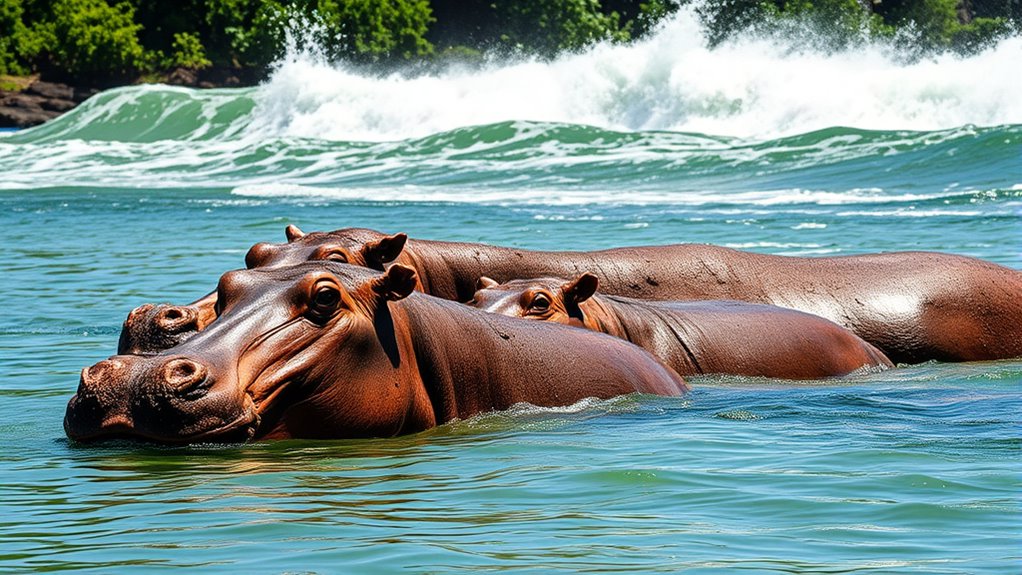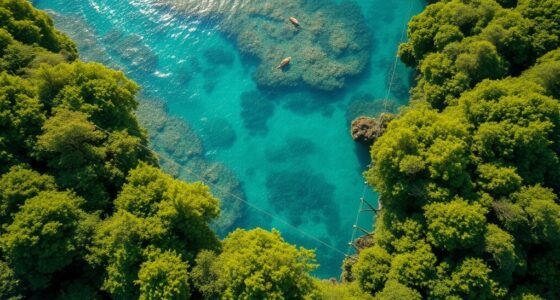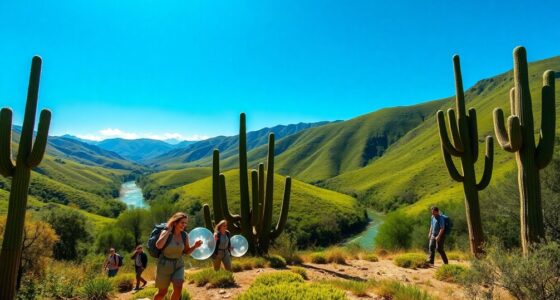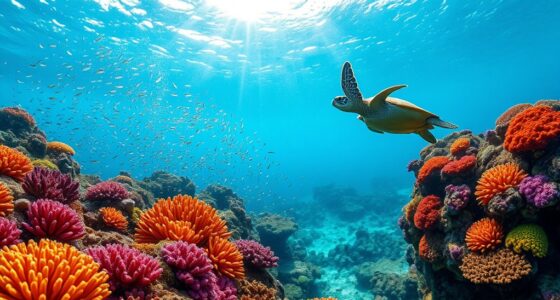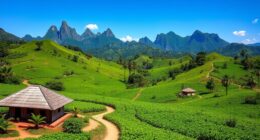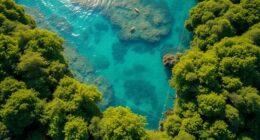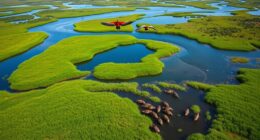In Gabon’s Loango National Park, you can witness playful hippos riding waves, a unique behavior that highlights their strong adaptations to aquatic life. The park’s diverse ecosystems, from wetlands to savannas, support rich biodiversity and are essential for conservation efforts. Local communities and sustainable ecotourism play key roles in protecting these habitats. If you keep exploring, you’ll discover how conservation initiatives help preserve Loango’s remarkable wildlife and guarantee a thriving future.
Key Takeaways
- Loango National Park is renowned for its unique surfing hippos engaging in playful wave-riding behavior.
- Hippo surfing attracts ecotourism, raising awareness about their ecological importance and the park’s biodiversity.
- Conservation efforts focus on protecting hippos and their habitats from threats like poaching and habitat fragmentation.
- Ecosystem health, water quality, and habitat restoration are vital to sustaining the park’s diverse wildlife.
- Climate change poses challenges, emphasizing the need for adaptive strategies to preserve Loango’s ecological resilience.
The Unique Habitat of Loango National Park
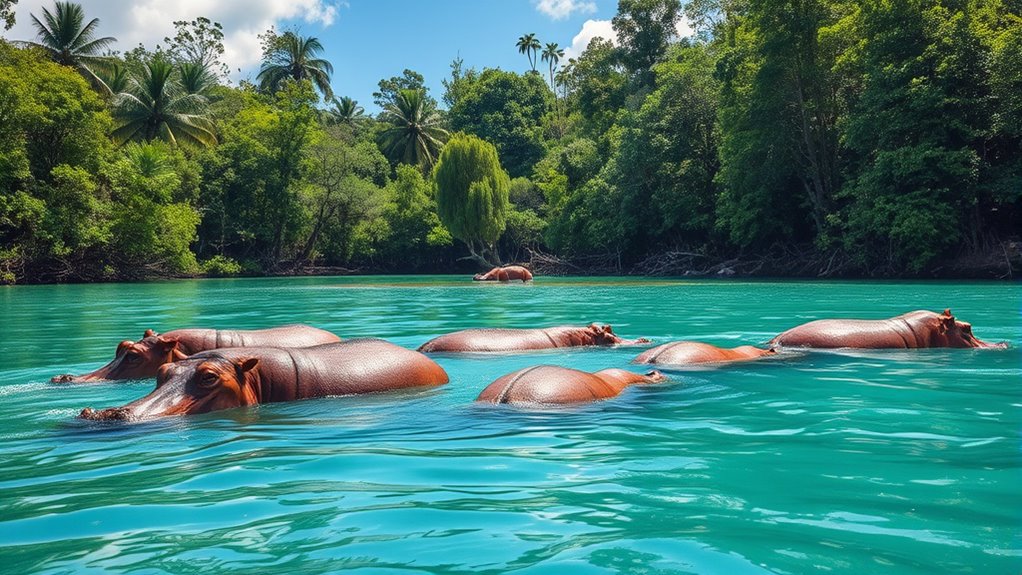
Loango National Park boasts a truly unique habitat where lush rainforests meet expansive savannas and pristine beaches. This diverse environment supports fascinating wildlife behaviors, like hippo migration across different water bodies. As hippos move between rivers and coastal waters, they influence water quality, maintaining a healthy aquatic ecosystem. The water’s clarity and health are essential for supporting fish populations and other aquatic life, which in turn sustain predators and scavengers. The park’s varied landscape creates ideal conditions for these migrations, ensuring hippos can access food and breeding grounds. The presence of high-quality water is vital for the health of this ecosystem, supporting both aquatic and terrestrial species. Your visit offers a chance to witness these natural movements firsthand, highlighting the delicate balance of this habitat. Protecting water quality is indispensable for maintaining the park’s vibrant biodiversity and the ongoing spectacle of hippo migration.
The Phenomenon of Surfing Hippos

You might be surprised to see hippos riding the waves at Loango, a behavior that captures both curiosity and wonder. These animals use their powerful bodies to balance and glide across water surfaces, showcasing surprising agility. Understanding this phenomenon highlights the importance of conservation and ecotourism efforts that protect these remarkable behaviors. Creating a relaxed environment with cozy textiles and natural decor can help visitors appreciate the tranquil beauty of the habitat that supports such extraordinary animal activities.
Hippos’ Surprising Behavior
Have you ever wondered how hippos manage to navigate the water with such surprising agility? Their water adaptation allows them to move swiftly, often surprising onlookers. Hippos communicate through loud vocalizations, which reveal their social dynamics and emotional states. Their behavior includes more than just resting; they often display unexpected actions like “surfing,” where they ride waves or push off the bottom. Interestingly, their essential oils for respiratory health help maintain their respiratory efficiency, supporting their active aquatic lifestyle. Here’s what you should know:
- Hippos use vocalizations to coordinate movement and alert others to danger.
- Their water adaptation enables quick turns and bursts of speed, defying their bulky appearance.
- Surfing behavior demonstrates their playful side and natural ability to navigate complex water conditions.
This behavior highlights their remarkable adaptability and social complexity.
How Hippos Surf Water
Hippos exhibit a surprising and playful behavior known as surfing, where they ride waves or push off the bottom to glide across the water’s surface. This activity isn’t just fun; it’s part of how they communicate and interact. When hippos surf, they send out vibrations and sounds through the water, signaling dominance or alerting others to their presence. Water temperature plays a role too—warmer waters make surfing easier, encouraging more playful behavior. Hippos often surf to establish social bonds or assert territory, using their movements to communicate without words. You might notice them riding waves during warm days, showcasing their agility and social nature. Surfing isn’t just a game; it’s a essential part of how hippos connect within their aquatic environment. Additionally, social bonding can be strengthened through these playful interactions, highlighting the importance of water behaviors in their social structure.
Conservation and Ecotourism
The playful surfing behavior of hippos has become a powerful tool for promoting conservation and ecotourism in Gabon’s Loango National Park. This unique phenomenon attracts visitors, highlighting the park’s rich biodiversity, including marine mammals and bird migration patterns. Your involvement helps sustain local communities and preserves this essential ecosystem. Promoting active engagement with conservation efforts fosters a deeper connection between visitors and the environment, encouraging ongoing support. To maximize impact, focus on:
- Educating visitors about hippos’ role in maintaining water quality and supporting marine mammals.
- Promoting responsible tourism that minimizes habitat disruption, especially during bird migration seasons.
- Supporting conservation initiatives that protect the park’s diverse species and their natural behaviors.
Behavior and Adaptations of Loango’s Hippos
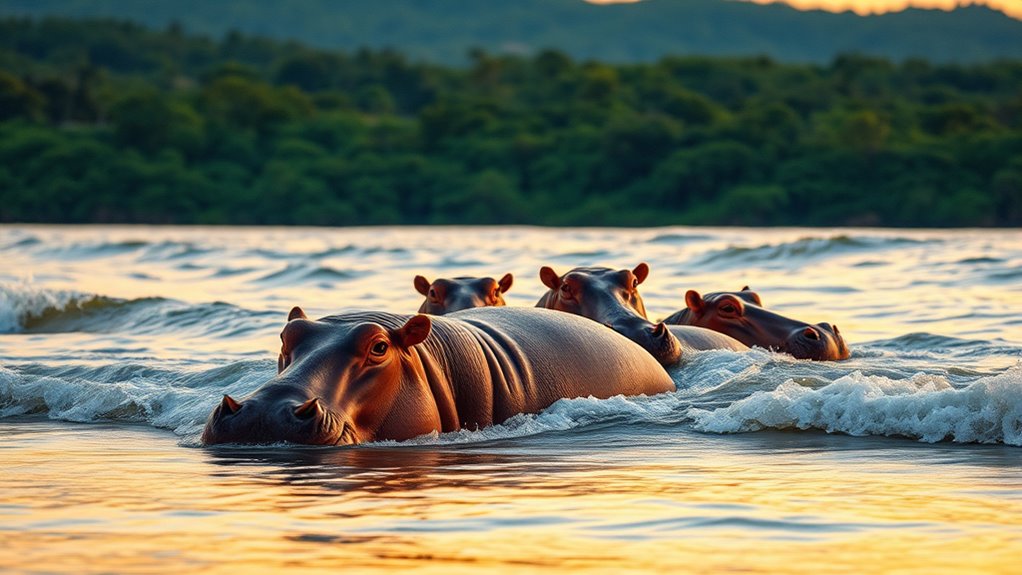
Despite their large size, hippos in Loango National Park exhibit remarkable behavioral adaptations that help them thrive in their aquatic environment. They communicate through distinct hippo vocalizations, which are essential for social bonding and alerting others to danger. These vocalizations vary depending on their context, from grunts to bellows, and can travel long distances underwater. Hippos are also highly sensitive to water temperature; they prefer warm waters that keep their bodies comfortable and aid in thermoregulation. During the day, they spend most of their time submerged, conserving energy and avoiding the sun’s heat. At dusk, they emerge to graze, but their aquatic habits remain central to their survival, showcasing their specialized adaptations to life in Loango’s rivers and coastal waters. Additionally, their specialized respiratory systems allow them to stay submerged for several minutes while remaining alert.
The Biodiversity of Loango’s Ecosystem
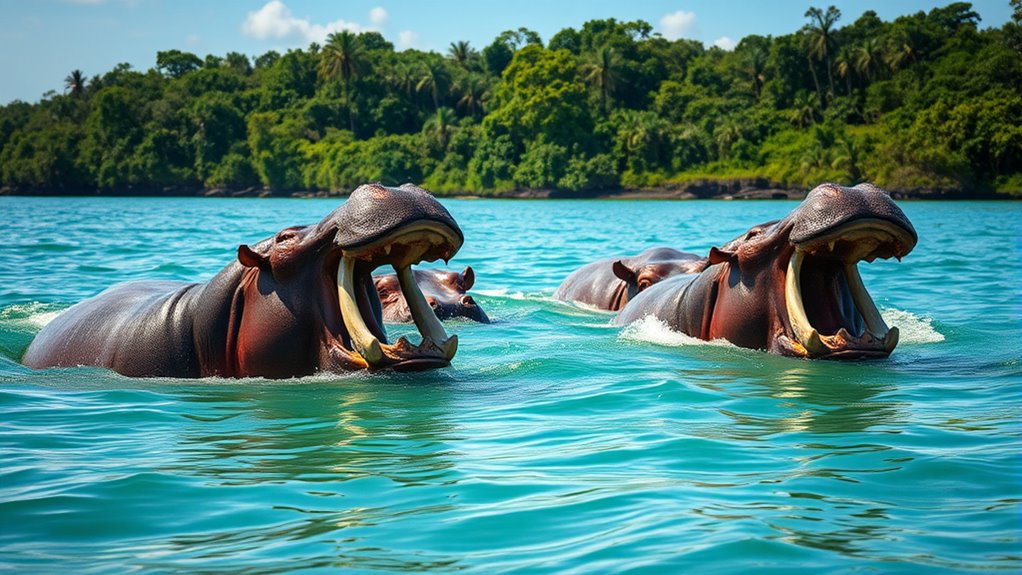
You’ll notice that Loango’s ecosystem hosts a remarkable variety of species, making it one of Africa’s most diverse habitats. Its unique landscape features wetlands, savannas, and forests, supporting countless forms of life. Additionally, you’ll find several endangered animals here, highlighting the park’s essential role in conservation. The park’s biodiversity hotspots are vital for protecting endemic species threatened by human activities.
Rich Species Diversity
Loango National Park boasts an astonishing array of species that thrive across its diverse habitats. You’ll find a rich mix of mammals, birds, and aquatic life that demonstrate the area’s ecological complexity. This diversity is evident in:
- The variety of herbivores, from hippos involved in mating displays to elephants roaming the savannahs.
- The predator-prey interactions, such as lions stalking antelopes and crocodiles lurking near water sources.
- The abundance of bird species, including colorful kingfishers and raptors soaring above the forest canopy.
- The critical role of AI security in monitoring and protecting this rich biodiversity from emerging threats.
This incredible biodiversity supports complex food webs and guarantees ecosystem resilience. Hippos, in particular, play a crucial role in shaping aquatic habitats, while predator interactions help maintain balanced populations, highlighting the vibrant life that makes Loango a true ecological treasure.
Unique Habitat Features
Loango’s landscape is characterized by a remarkable mosaic of habitats that support its rich biodiversity. This diversity creates unique environments where hippos thrive, especially in the wetlands and river systems. You’ll notice how hippo communication plays a crucial role in their social interactions, often through grunts and underwater sounds. These aquatic habitats are also teeming with aquatic plant life, which forms the foundation of their diet. The lush vegetation along the banks provides cover and breeding grounds, enhancing the ecosystem’s complexity. The interplay of freshwater and coastal zones fosters a rich tapestry of life, making Loango’s habitat features truly exceptional. Incorporating environmental conservation efforts is essential for maintaining these habitats and supporting the park’s biodiversity. By preserving these habitats, you help maintain the delicate balance that sustains the park’s extraordinary biodiversity.
Endangered Wildlife Presence
Did you know that Loango National Park is a essential refuge for several endangered species? The park supports species like forest elephants, western lowland gorillas, and the iconic hippos. You can observe hippo migration patterns along the coast, where they move between freshwater and marine environments, showcasing their adaptability. Predator interactions also shape the ecosystem, with lions and crocodiles regularly preying on vulnerable animals, maintaining balance. The park’s diverse habitats provide crucial wildlife corridors that facilitate animal movement and genetic exchange. Here’s what makes Loango indispensable for endangered wildlife:
- Hippo migration ensures their survival and genetic diversity.
- Predator interactions influence animal behavior and population health.
- Conservation efforts help protect these species from poaching and habitat loss.
Ecotourism and Its Impact on the Park
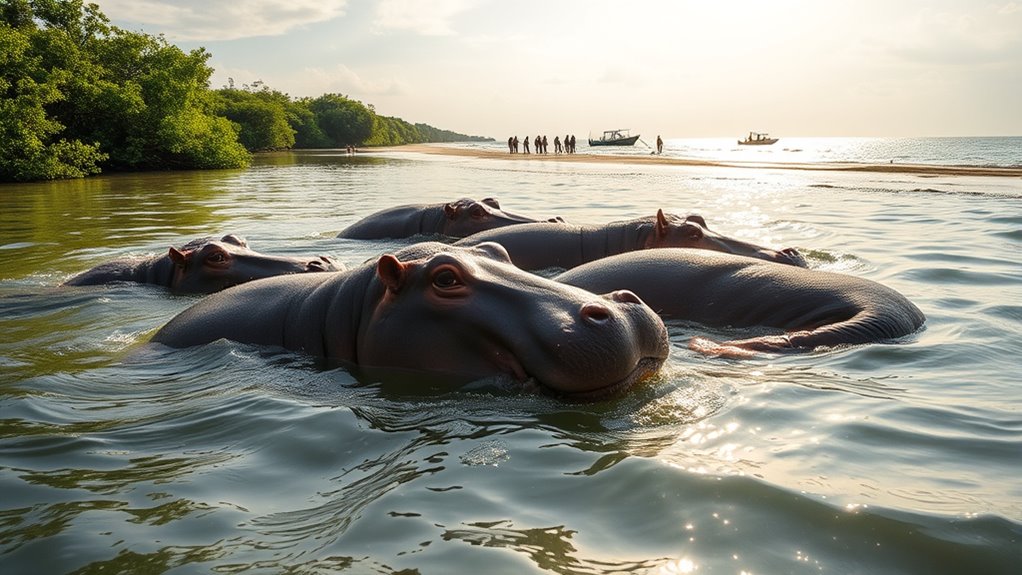
Ecotourism in Gabon’s Loango National Park has grown rapidly, bringing both opportunities and challenges. You can now experience incredible wildlife photography moments and immerse yourself in vibrant cultural tourism. However, increased visits can disturb animal habitats and strain local communities. Balancing tourism with conservation is essential. Consider the emotional connections you foster with nature and local cultures, like:
| Impact | Positive | Negative |
|---|---|---|
| Wildlife | Inspires conservation efforts | Disrupts animal behavior |
| Culture | Promotes cultural pride | Commercializes traditions |
| Environment | Funds park preservation | Contributes to habitat degradation |
Your responsible actions can help protect Loango’s unique wildlife and cultural heritage, ensuring future generations can enjoy its wonders.
Conservation Challenges Facing Loango

You need to be aware of the threats Loango faces from poaching and illegal hunting, which endanger many species. Habitat fragmentation and loss from human activities also threaten the park’s delicate ecosystems. Addressing these challenges is essential to protect Loango’s unique biodiversity for future generations.
Poaching and Illegal Hunting
Poaching and illegal hunting pose significant threats to Loango National Park’s rich biodiversity, undermining efforts to conserve its unique species. Poaching threats target animals like elephants, gorillas, and hippos, reducing populations and disrupting ecosystems. Illegal hunting often occurs because of high demand for bushmeat and wildlife products, fueling further destruction. To combat these issues, efforts focus on:
- Increasing patrols and surveillance to deter poachers.
- Strengthening community engagement and alternative livelihoods.
- Enforcing stricter laws and penalties for illegal hunting.
Despite these measures, poaching threats remain persistent, challenging conservationists to protect Loango’s vulnerable species and ensure the park’s ecological integrity for future generations.
Habitat Fragmentation and Loss
Despite efforts to combat poaching, habitat fragmentation and loss continue to threaten Loango National Park’s vibrant ecosystems. Urban expansion nearby encroaches on the park’s borders, reducing habitat connectivity for wildlife. Agricultural development further fragments the landscape, converting forests and wetlands into farmland, which disrupts animal movement and plant diversity. These activities create isolated patches of habitat, making it harder for species to find food, mates, and shelter. As habitats shrink, the risk of species decline and local extinctions increases. To protect Loango’s rich biodiversity, you must support sustainable land-use practices and advocate for policies that limit unchecked urban growth and agricultural expansion. Preserving habitat integrity is vital to maintaining the park’s ecological balance and resilience against ongoing threats.
Initiatives and Projects Protecting the Wildlife

Several dedicated initiatives and projects actively work to protect the diverse wildlife of Loango National Park. These efforts focus on maintaining healthy ecosystems vital for species like hippos, especially during migration periods. Key projects include:
- Monitoring water quality to guarantee clean habitats for aquatic life.
- Protecting migration corridors to allow safe movement of hippos.
- Engaging in anti-poaching efforts to safeguard vulnerable species.
These initiatives help sustain the natural balance, making certain water quality remains high and migration routes stay unobstructed. By prioritizing habitat preservation and addressing threats directly, conservationists aim to support the park’s rich biodiversity. Your support and awareness can help promote these projects, securing Loango’s wildlife for future generations.
The Role of Local Communities in Conservation

Local communities play a vital role in conserving Loango National Park’s rich biodiversity. Your involvement guarantees that indigenous traditions are respected and integrated into conservation efforts, creating a sustainable balance between people and nature. Through community-led initiatives, locals actively participate in protecting wildlife, managing resources, and preventing illegal activities like poaching. These initiatives empower residents to take ownership of their environment, fostering a sense of pride and responsibility. By blending traditional knowledge with modern conservation practices, you help sustain the park’s unique ecosystems. Your support also encourages collaboration with park authorities, strengthening conservation strategies. Ultimately, the success of preserving Loango’s biodiversity depends on your commitment and the active role you play in community-driven efforts.
How Visitors Can Contribute to Preservation Efforts
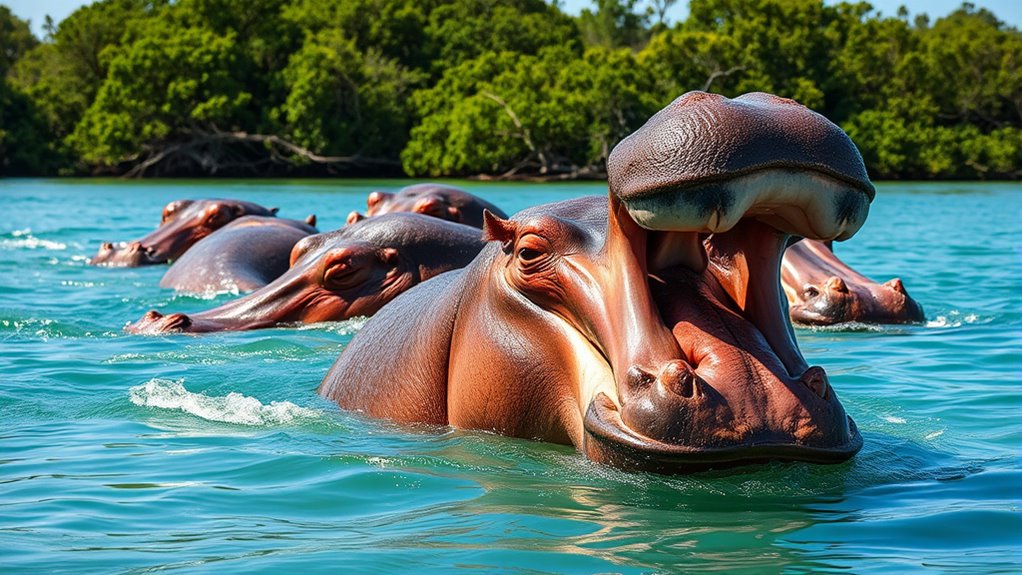
You can make a meaningful difference in Loango National Park by practicing responsible tourism. Your actions directly impact hippo behavior and water conservation efforts. To contribute effectively, consider these steps:
- Respect wildlife boundaries, avoiding disturbances that can stress hippos or alter their natural water habits.
- Minimize water use during your visit, helping preserve water sources essential for hippo health and park ecosystems.
- Follow park guidelines on waste disposal, preventing pollution that affects water quality and animal behavior.
Future Outlook for Loango’s Wildlife and Ecosystems

Looking ahead, the future of Loango National Park’s wildlife and ecosystems depends on ongoing conservation efforts and sustainable practices. To build climate resilience, you’ll need to support initiatives that protect habitats from climate change impacts, such as rising temperatures and unpredictable weather patterns. Ecosystem restoration will play a vital role in reversing damage caused by deforestation, poaching, and human activity. By actively participating in habitat rehabilitation projects, you help guarantee that species like hippos, elephants, and gorillas continue to thrive. Strengthening the park’s natural defenses and restoring degraded areas will safeguard biodiversity for future generations. Your commitment to conservation not only preserves Loango’s unique ecosystems but also enhances their resilience against climate challenges, securing a vibrant, sustainable future for the park.
Frequently Asked Questions
How Do Surfing Hippos Affect Other Aquatic Species in Loango?
You might wonder how surfing hippo behavior impacts other aquatic species. When hippos engage in surfing, they often dominate the water, disrupting aquatic competition. This behavior can limit space and resources for fish and smaller animals, potentially reducing biodiversity. By monopolizing prime areas, hippos influence the ecosystem balance, making it harder for other aquatic species to thrive. Your awareness of this interaction highlights the importance of conserving natural behaviors and habitats.
Are There Any Rare or Endangered Species Unique to Loango?
You’ll find that Loango National Park is home to rare and endangered species, making it a true sanctuary for unique fauna. You might encounter forest elephants, western lowland gorillas, and the elusive African grey parrots, all essential to the ecosystem’s health. These endangered species thrive here due to the park’s protection efforts. Visiting, you become part of the effort to conserve these remarkable creatures and preserve their unique habitats.
What Are the Most Effective Ways for Tourists to Minimize Their Ecological Footprint?
Imagine walking through lush forests, leaving footprints behind, but not harming the vibrant life around you. To minimize your ecological footprint, embrace eco-friendly travel and wildlife responsible tourism. Avoid single-use plastics, stick to designated paths, and respect wildlife distances. Support local conservation efforts and choose eco-conscious tour operators. Your mindful actions help preserve fragile ecosystems, ensuring future generations can experience the beauty and diversity of places like Loango National Park.
How Does Climate Change Threaten Loango’S Ecosystems and Wildlife?
Climate change threatens Loango’s ecosystems and wildlife by disrupting climate resilience, making habitats more vulnerable. Rising temperatures and changing rainfall patterns cause habitat loss, which affects animals like hippos and elephants. You can help by supporting conservation efforts that strengthen ecosystem resilience. Reducing carbon footprints and raising awareness also play key roles in protecting Loango’s rich biodiversity from the intensifying impacts of climate change.
What Are the Long-Term Conservation Goals for Loango National Park?
You should focus on enhancing ecosystem resilience by protecting diverse habitats and species in Loango National Park. Long-term conservation goals involve actively engaging local communities to foster sustainable practices and support conservation efforts. By empowering residents, you help guarantee the park’s ecological health and resilience. This collaborative approach promotes biodiversity, preserves ecosystems, and secures the park’s natural beauty for future generations.
Conclusion
As you stand on Loango’s shimmering shores, imagine the surfing hippos gliding effortlessly through the waves, a living demonstration of nature’s resilience. Your presence can help protect this vibrant paradise, ensuring future generations witness its breathtaking harmony. By supporting conservation efforts and respecting the land, you become part of the story—where wild music, rolling tides, and thriving ecosystems remind us of our shared duty to preserve these precious moments of life’s wonder.

